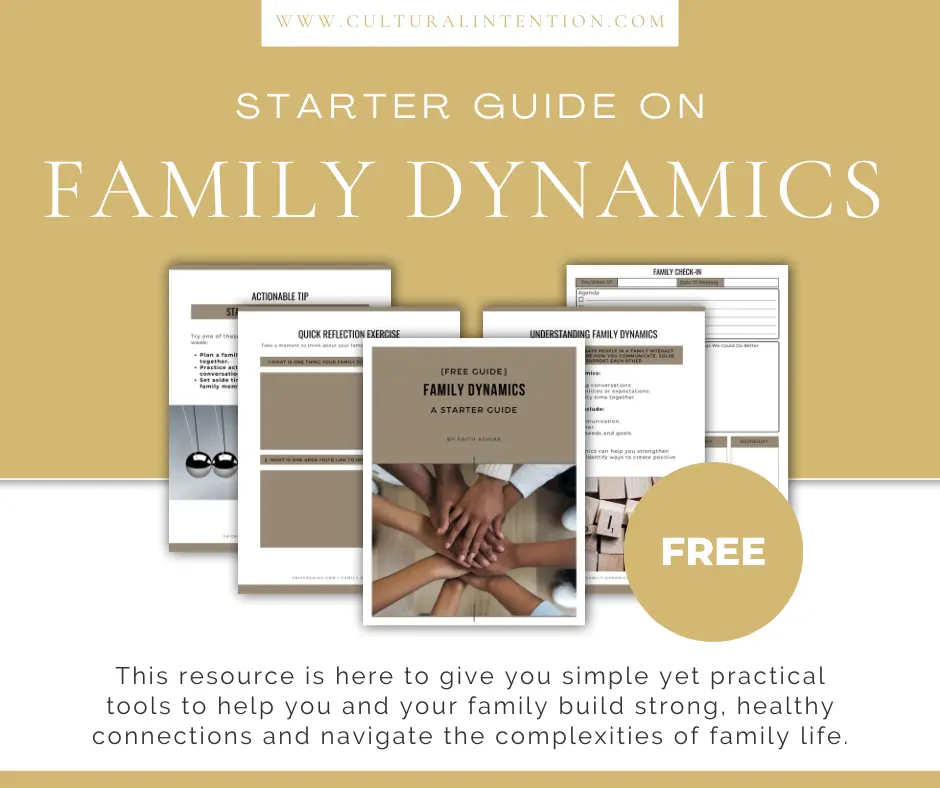7 Activities for Family Happiness: Simple Ways to Make Life Fun

Do you ever feel like you could use a little more happiness in your life? As a parent, it can be challenging to balance the demands of family life with your own happiness.
However, the science of happiness and positive psychology has shown that there are practical activities families can engage in to increase overall happiness and well-being.
One way to raise happiness in your family is to prioritize quality time together. This can include activities such as family game nights, movie nights, or even walking together.
By spending intentional time together, you strengthen your family bonds and create positive memories that can boost overall happiness.
Another practical activity to increase happiness in your family is to practice gratitude. This can be as simple as taking a few minutes each day to reflect on your gratitude and sharing those things with your family.
By focusing on the positive aspects of your life, you can increase feelings of happiness and contentment.

Ready to Create More
Peace and Connection at Home?
Download your FREE starter guide on Family Dynamics to create healthy communication, build stronger bonds, and navigate challenges with intention.
Understanding Happiness
Happiness is a positive emotion associated with emotional well-being and mental health, and it positively affects our lives.
It is a state of being often associated with joy, contentment, and satisfaction.
However, happiness is not just a state of mind; it is a science that has been extensively studied by researchers.
The Science of Happiness
The science of happiness explores what truly contributes to our sense of well-being. It turns out that happiness isn’t solely about external achievements like wealth, good health, or high social status.

Rather, it involves internal factors – thoughts, emotions, and behaviors.
There are some science-backed ways to boost your happiness. Here are a few practices:
- Mindfulness Meditation: This is all about centering yourself and reducing stress. It can really help you feel more content.
- Prayer: It offers peace and can strengthen your emotional resilience.
- Gratitude Journaling: When you start noting the good things in your life, believe me, it shifts your outlook and brings more joy.
- Acts of Kindness: Doing nice things for others doesn’t just make them smile—it boosts your mood, too, creating an awesome cycle of feel-good vibes.
These activities aren’t just feel-good tasks to tick off your to-do list.
They reduce negative feelings like anxiety and depression and increase positive feelings such as joy and contentment.
It's pretty interesting to think about, especially when you see people who seem to have it all but aren't happy.
It really highlights how important it is to focus on our inner emotional well-being if we want to find true happiness.

Emotions and Well-Being of Happiness
Emotional well-being is an important aspect of overall happiness. People who experience positive emotions like joy, contentment, and satisfaction are more likely to have better emotional well-being.
Negative emotions such as anxiety, anger, and sadness can negatively impact this well-being.
Recognizing and managing negative emotions is important to improve emotional well-being and increase happiness levels.
Implementing positive thoughts and behaviors, such as practicing gratitude, engaging in physical activities, and spending time with loved ones, effectively improves emotional health.
Happiness and Mental Health
Happiness is closely linked to mental health for several reasons:
- Positive Emotion Influence: When you frequently experience positive emotions, it does more than make you feel good; it helps reduce stress hormones and promotes behaviors that benefit your health. If you regularly feel these positive vibes, you'll likely be more resilient against life's challenges. This resilience can shield you from mental health issues that often get worse with stress, like depression and anxiety.
- Cognitive Effects: Higher happiness levels are linked to seeing the world in a better light. If you're generally a happy person, you'll tend to have a more positive outlook, which contributes to mental stability and lowers your chances of developing mood disorders. This positive perspective helps you cope better with stress and bounce back faster from setbacks.
- Enhanced Social Connections: Feeling happy boosts your social life, leading to stronger and more supportive relationships. These connections offer emotional support, advice, and practical help, vital for mental resilience. Strong social ties are a big plus and are known to guard against mental health issues.
- Healthy Lifestyle Choices: If you're happier, you're also more likely to make healthy choices like exercising regularly, eating well, and getting enough sleep. These habits improve your physical health and are crucial for your mental well-being. For instance, regular exercise is famous for helping reduce symptoms in people dealing with depression.
- Neurochemical Benefits: Your happiness can affect the levels of certain brain chemicals, such as serotonin, dopamine, and endorphins, which are key players in regulating your mood. Higher levels of these neurotransmitters can boost your well-being and help keep symptoms of mental health disorders at bay.
It’s important to recognize the signs of poor mental health and seek help when necessary.
Engaging in positive behaviors, seeking professional help, and taking time for self-care are key steps to boosting mental health and elevating happiness.
In all honesty, keeping your spirits up can be tough, especially during hard times.
But by incorporating the previously mentioned science-based exercises, keeping those negative emotions in check, and asking for help when you need it, you can significantly improve your emotional well-being, mental health, and overall happiness.
Creating a Happy Family Environment
Creating a happy home environment is important for everyone's well-being as a family.
Here are some simple steps you can incorporate to promote positivity and happiness in your family and around your home.
Importance of Positive Communication on Strong Relationships
Positive communication is the foundation of any strong relationship, and this is especially true for families.
Communicating effectively and openly with your family members is important to build strong bonds and close relationships.
To promote positive communication, try to:
- Actively listen to each other
- Avoid interrupting or talking over one another
- Show empathy and understanding
- Use “I” statements instead of “you” statements
- Avoid blaming or criticizing each other

Building Strong Family Relationships
Tight-knit family bonds don't just happen; it takes time and effort. Here’s how to create lasting memories and strengthen your family bond.
- Have meals together at the dinner table. It’s simple yet super effective!
- Plan fun activities or outings. It could be a movie night or a day at the park – whatever works for your family.
- Keep the lines of communication open. Honesty really is the best policy here.
- Don’t forget to show how much you appreciate each other. Little thank yous and compliments go a long way.
- Be there for one another and support each other.
Managing Conflict and Anger
Let’s face it: Conflict, anger, and disagreements are part of everyday family life. But it's important to keep those arguments healthy and constructive.
Learning to resolve conflicts peacefully and manage anger can help promote a happier family environment.
- Take a break if things get heated – sometimes a little space can prevent a big blowout.
- Talk about your feelings calmly and clearly, sticking to “I” statements.
- Avoid blaming or hurtful name-calling.
- Work on compromising – it’s all about give and take.
- If you’re stuck, sometimes a bit of outside perspective can help! It is okay to seek outside help if needed.
By focusing on positive communication, building strong relationships, and managing conflict and anger, you can create a happy and harmonious family environment that promotes well-being and happiness for everyone.
Practical Activities for Family Happiness
Need some fun ideas and practical activities to bring a bit of happiness into your family life?
Here are some great ideas to get you started and bring smiles to everyone’s faces:

Art and Creativity
Let your family’s creative side shine through! Whether it's painting, doodling, drawing, or crafting, there’s something for everyone to enjoy.
Art isn’t just fun; it lets everyone express themselves and can be a great outlet to deal with all those extra emotions.
Plus, the pride in showing off everyone's finished piece? It's a huge boost of confidence for both our kids and grown-ups!
Physical Exercise and Nature
Outdoor activities are a great way to get some exercise and fresh air while also having fun.
Whether it's a hike, bike ride, or a game of tag, there are plenty of options to choose from.
These activities aren’t just good exercise; being in nature has been shown to have a positive impact on mental health, so it's a win-win for everyone.
Plus, they can create lasting memories for your family.

Music, Dance, and Games
Music, dance, and games are all great ways to bring joy and laughter into your family's life.
Whether you sing along to your favorite songs, have a dance party in the living room to shake off the day's stress, or play a board game, these activities do more than just entertain.
They teach teamwork and problem-solving, all while everyone’s laughing and having a good time.
Our children absolutely adore dance parties, and their diverse playlists are often used well in our home.
Growing up, we didn't have dance parties too often. However, I fondly remember my mom turning on music and showing us Adwoa Dance, a form of non-verbal communication through gestures that originates in Akan royal tradition.
It was more than just dancing; it was a way of connecting with our heritage and appreciating a language of expression passed down through generations.
Seeing how these joyful traditions continue and create new memories is great. But what happens when families struggle to find something we all enjoy doing together?
That’s a challenge many of us face, especially with different interests and age groups under one roof.
Incorporating these practical activities for family happiness into your family's routine can positively impact everyone’s well-being. Speaking of fun, lately, I’ve been finding easy-to-follow, low- or no-prep games that we play with the family, and the kids absolutely love them. There are many fantastic resources out there that make family time both joyful and effortless.
So why not try one out today and see how much fun you can have together?

Developing Positive Habits and Skills for Family Happiness
Building positive habits and skills as a family isn’t just rewarding; it’s a fun way to lead happier and more fulfilling lives together.
Here are some practical activities to get everyone involved and start nurturing these great habits.
Gratitude and Appreciation
Gratitude practice is a simple way to bring more positivity into your daily lives. How about starting a daily gratitude practice?
It can be simple: encourage each family member to share something they are grateful for daily or weekly.
You can also create a family gratitude journal in which you write down positive moments to read together later.
This is a great way to reflect on the good things in your life and develop appreciation.
Another great idea is to start a gratitude jar or a gratitude tree, where each family member adds leaves with written notes of gratitude regularly.
This can be especially meaningful for younger children and older kids, helping to strengthen a strong bond and raise happiness throughout the household.

Mindfulness and Awareness
Mindfulness practices can help you become more aware of your thoughts and emotions and develop a greater sense of calm and focus.
Try doing a simple breathing exercise together or take a mindful walk in nature.
Encourage each family member to be present in the moment and pay attention to their surroundings. This can be a great way to reduce stress and anxiety.
Setting and Achieving Goals
Setting goals is an important practical life skill that can help you achieve your dreams and aspirations, something the whole family can support.
Encourage each family member to set a personal goal, whether it's learning a new skill, finishing a project, or accomplishing a task.
Help them break down the goal into smaller, achievable steps, and celebrate their progress along the way.
This can be a great way to build confidence and develop new skills.
With a bit of practice in gratitude, mindfulness, and goal-setting, you’ll be amazed at how these positive habits and skills can lead to a happier and more fulfilling life at home.
Building Resilience and Personal Growth When Working toward Family Happiness
Overcoming Stress and Unhappiness
Stress is a natural part of life, and sometimes it can be overwhelming. When you're feeling stressed, it's important to take time to relax and recharge.
It can be as simple as taking a few deep breaths, going for a walk, or spending time with loved ones; these can make a big difference.
Managing your stress effectively not only helps you build resilience but also improves your overall well-being.
One way to manage stress is to focus on the present moment. It’s a great way to stay centered and calm no matter what’s going on.

You can also try practicing gratitude by writing down three things you're thankful for each day.
This can help shift your focus from negative thoughts to positive ones.
Learning from Challenging Experiences
Difficult times aren’t just obstacles; they're opportunities for personal growth.
When you face challenges, it's important to approach them with a growth mindset. This means viewing setbacks as opportunities to learn and improve, rather than as failures.
Consider making ‘lesson plans' for yourself after going through a rough season.
Think about what you can learn from difficult experiences, and how to apply those lessons to future situations.
It's also important to remember that personal growth is an individual journey. Everyone's path is different, and what works for one person may not work for another.
By focusing on building resilience and embracing personal growth, you’re not just surviving; you’re setting yourself up for a happier, more fulfilling life.

Enhancing Community and Social Connections for Overall Family Happiness
Getting Involved in Community Activities
Building a strong sense of community and social connections is essential for overall happiness and well-being.
Getting involved in social events is a fantastic way to meet new people, and feel connected, supported, and valued.
Why not try joining a local sports team, volunteering at a community center, attending a cultural festival, or helping in a charity event?
These activities can help you feel a sense of belonging and purpose, and provide opportunities to connect with like-minded people.
Sharing Happiness with Others
One of the best ways to boost your social connections is by sharing your happiness with others.
Simple things like expressing gratitude, spreading kindness, and offering compassion can really make someone’s day.
Celebrate your wins with friends, share your happy moments, and don’t forget to spread that joy around.
And you know what? Helping out others isn’t just good for them—it makes you feel good about yourself, too.
Getting out there and weaving stronger community and social support is a huge part of feeling a sense of belonging and positive emotions.
Now, if you're an introvert like me, this might sound a bit intimidating, but trust me, it's so worth it.
Stepping out of our comfort zones can lead to some of the most rewarding connections.
So, take it one step at a time, meet new people, and enjoy the many benefits of being part of a supportive and connected community!
Overcoming Challenges to Family Happiness
I assume and hope that we all enter family life with the expectation of happiness and a happy family, but often, it's quite challenging to achieve.
Busy schedules, never-ending to-do lists, chores, and the usual ups and downs can sometimes get in the way.
However, with practical tips and a positive attitude, you can overcome these challenges and create a family atmosphere that values and respects each other.

Addressing Common Obstacles in Pursuing Family Happiness
Finding enough quality time is one of the most common obstacles to family happiness. With work, school, extracurricular activities, and other commitments, it can be challenging to connect as a family truly.
You might be in the same space most of the time, but the stress of juggling a full calendar can make it feel like you're just passing each other by.
The trick is to prioritize it and be intentional – make dedicated family time part of your schedule.
Set aside specific days or times for family activities, such as game nights, movie nights, or outings.
Another common obstacle in family dynamics is a lack of positive communication. Communication is key to building strong relationships and resolving conflicts.
It’s all about building bridges, not walls. Encourage open and honest communication among family members and ensure everyone feels heard and valued.
Avoid negative communication, such as criticism or blaming, and focus on finding solutions to problems together.
Ensuring Every Family Member Feels Valued and Heard

It's essential to ensure that every family member feels valued and heard. Encourage each family member to share their thoughts and feelings, and make sure everyone's opinions are respected.
Avoid favoritism and ensure that everyone is included in family activities and decisions.
Creating an inclusive family environment can also help ensure that everyone feels that their voice matters.
Celebrate each family member's unique qualities and interests and encourage them to pursue their passions.
Support each other and work together towards common goals.
Let's make happiness a family project!
Incorporating practical happiness activities into your family’s daily routine can really shake things up and significantly boost your overall well-being.
Imagine the uplift in your family’s spirits from simple practices like gratitude journaling, mindfulness exercises, spending quality time together, and nurturing a positive and supportive environment.
Keep those lines of communication wide open. Encourage discussions about what makes each person happy and how you can work together to achieve those goals.
This can greatly strengthen unity and develop a shared purpose within your family.

Moreover, try to make these activities a regular part of your daily routine. Consistency is key to nurturing happiness and well-being.
Consider creating a schedule or checklist to prioritize and track these activities.
Remember, the little things done regularly contribute to a happier, more meaningful life.
Why not start today and watch the positive changes in your family’s daily life?
IF THIS POST SPOKE TO YOU, EXPLORE MORE OF THE JOURNEY ON OUR SITE.
You'll find free guides, intentional tools, and reflections to support cultural growth and legacy-building.
💬 Looking for connection? Join our Facebook community to continue the conversation.
📌 Pin an image to revisit or share with someone walking a similar path.
Thank you for being here.









